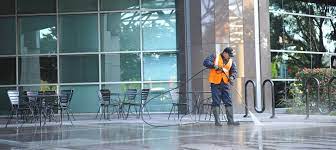Pressure washing is a common form of maintenance that is used to keep commercial properties in top condition. It has become increasingly popular due to its ability to restore and preserve the appearance of surfaces such as concrete, stone, brick and wood. Coincidentally, it can also help reduce energy costs by improving the insulation of buildings and removing dirt and debris from outdoor areas.
This article will explore the role of pressure washing in commercial property maintenance, including the benefits, common tasks, safety precautions and equipment required.
Overview of Pressure Washing
Pressure washing is a powerful tool utilized in the maintenance of commercial properties, providing efficient and effective cleaning solutions. This technique utilizes high-pressure water jets to physically remove dirt, debris, and other contaminants from surfaces. With an understanding of how pressure washing works and proper selection of chemicals, it can be used safely and effectively to clean even the most challenging surfaces. The amount of water usage required for pressure washing can vary depending on the size of the surface being cleaned and how much debris needs to be removed.
For large spaces or areas with excessive buildup, more water may be necessary in order to achieve desired results. Additionally, careful chemical selection is important when using pressure washers; certain chemicals are not appropriate for certain surfaces or situations. It is also important that operators thoroughly understand safety measures associated with using pressure washers before engaging in any cleaning activities. Cleaning professionals must possess an understanding of both the chemical components and physical elements involved in effective pressure washing. When done correctly, this process can leave commercial properties sparkling clean without damaging their underlying structure or leaving behind any hazardous materials.
Pressure washing is one way to maintain a safe environment while keeping businesses looking their best at all times.
Benefits of Pressure Washing
Pressure washing is an efficient and cost-effective method for improving the appearance of a building. It is also effective in removing unwanted debris and contaminants. This type of cleaning prepares the surface for painting or coating, making it easier to maintain the property. Pressure washing can help keep a commercial property looking its best while simultaneously preserving its value over time.
Improves Building Appearance
Adequate pressure washing of commercial property can result in a more aesthetically pleasing building, as dirt and debris buildup can detract from the overall appearance. Pressure washing is a highly effective method for reducing algae, mold, mildew, and other surface contaminants that are unsightly and potentially hazardous to one’s health. Pressure washing also helps increase curb appeal by restoring the building’s original look.
In order to ensure the desired results are achieved when pressure washing a commercial property, it is important to use powerful cleaning solutions along with specialized equipment that is designed to reach hard-to-reach areas like window frames and cornices. Additionally, it is important to take into consideration the type of material being cleaned before selecting an appropriate pressure washer setting so that damage is not caused while cleaning.
| Advantages | Disadvantages |
|:———–|:————-|
| Reduces algae build up | May cause damage if wrong setting used |
| Increases curb appeal | Specialized equipment needed for hard-to-reach areas |
| Restores building’s original look | Cleaning solutions may be harmful if mishandled or overused |
Removes Unwanted Debris and Contaminants
Using powerful cleaning solutions and specialized equipment, pressure washing can effectively remove unsightly debris and contaminants from commercial property. Pressure washing is especially helpful in reducing allergens such as dust, pollen, mold spores, and dirt that accumulate on the surfaces of buildings over time.
Additionally, this type of cleaning helps minimize odors caused by smoke, grease, pet waste, or other organic matter that are difficult to remove with traditional cleaning methods. Pressure washing not only eliminates these unwanted particles and residue but also kills bacteria and germs that may cause health problems for people occupying the building.
This type of deep-cleaning also prevents insect infestations by removing their food sources like standing water or organic matter from hard surfaces. Furthermore, it can brighten dulled paint finishes or strip away old paint layers to prepare for a new coat of paint. By providing superior results than manual scrubbing alone could achieve, pressure washing offers an efficient solution for cleaning commercial properties while protecting their occupants’ health and safety.
Prepares Surface for Painting or Coating
By carefully targeting high-pressure water streams to the necessary surfaces, pre-painting preparation can be achieved efficiently and effectively. Pressure washing is a cost-effective method of surface preparation that helps remove unwanted debris and contaminants while providing protection against future damage. This process not only ensures proper adhesion of the paint or coating but also extends the life of the surface.
Additionally, power washing reduces the amount of time needed for manual labor such as sanding and scraping, thus further increasing its cost effectiveness. In addition to cleaning surfaces prior to painting or coating, pressure washing offers superior protection against environmental factors like dirt, dust, mold, mildew, and other pollutants which can harm the integrity of a painted surface over time. Furthermore, it creates an even texture on any given surface making it easier for later applications such as staining or sealing to take hold properly.
As such, pressure washing is an essential part in commercial property maintenance and should not be overlooked when considering ways to improve overall building appearance and longevity.
Common Pressure Washing Tasks
Pressure washing is a powerful tool for tackling frequent commercial property maintenance tasks, allowing businesses to keep their buildings looking sharp as a tack. It involves the use of high-pressure water jets to remove dirt, grime, mold, algae and other contaminants from surfaces. Common pressure washing tasks include cleaning exterior walls and roofs, sidewalks and parking lots, decks and patios, driveways and walkways.
The effectiveness of pressure washing depends on several factors such as the type of surface being cleaned, the amount of dirt or debris present on the surface and the type of water pressure used. Pressure washers can be used with cold or hot water depending on the task at hand; however, cold water is more commonly used in commercial settings due to its cost-effectiveness. Different types of cleaning techniques can also be employed such as low-pressure rinsing for gently removing light soils or power scrubbing for heavy soil removal.
Pressure washing is an effective way to maintain commercial properties which helps to extend their lifespan and enhance their visual appeal. It also creates a safer environment by removing hazards such as slippery surfaces that may cause slips or falls. With regular use, it can help businesses save money by preventing costly repairs due to damage caused by debris accumulation over time.
Safety Precautions
While the array of common pressure washing tasks is extensive, it is essential to consider safety precautions when performing them. Protecting workers and avoiding injuries should always be paramount when operating a pressurized cleaning machine. This involves following certain guidelines and utilizing specific equipment. Most importantly, wearing protective gear such as goggles, boots with steel toes, long pants, and gloves is essential for any pressure washer job.
It is also important to make sure that the pressure washer being used meets OSHA standards for industrial use in order to ensure maximum protection of the user. Additionally, ensuring that all hoses are in good condition and properly connected before starting a job helps prevent spraying water at unsafe pressures which can cause damage or injury.
Finally, proper training and understanding of the machine’s capabilities are necessary prior to beginning any task so as not to exceed what the machine can safely handle without compromising safety or performance standards. Taking these safety measures into account will help ensure efficient operation while protecting both workers and property from potential harm.
Pressure Washing Equipment and Supplies
In order to successfully complete pressure washing tasks, the right equipment and supplies are essential. For starters, a power washer that is designed for commercial use is needed. This type of washer should have adjustable settings so that the user can adjust the pressure to clean the surface without damaging it. Additionally, it’s important to have access to water-saving accessories such as foam cannons and low-pressure nozzles in order to conserve water while cleaning.
Protective gear is also necessary when using a power washer, as high-pressure streams of water can be dangerous and cause injury if not properly handled. The user should wear protective goggles, gloves, and long pants or coveralls in order to protect themselves from potential harm. The supplies for pressure washing include detergents formulated specifically for particular surfaces being cleaned along with brushes or specialty tools used for scrubbing away dirt and debris that has accumulated on these surfaces over time. One should always follow instructions carefully when using a chemical detergent as improper use could damage the surface or put people at risk of exposure to hazardous chemicals.
Furthermore, biodegradable soaps and cleaners are recommended in order to reduce environmental impact by eliminating pollutants from entering into local waterways during rinsing operations. Finally, maintaining an inventory of spare parts is advised since some components of a power washer may need replacing over time due to wear and tear from consistent use. Having these parts readily available will minimize downtime caused by waiting for replacement parts due to machine failure or breakdowns during operation which could lead to costly delays if not anticipated beforehand.
Conclusion
Pressure washing is a highly effective method for maintaining commercial property. It not only enhances the aesthetic appeal of a building, but also helps reduce the risk of damage from dirt and other debris. In addition to improving the appearance of a property, pressure washing can help extend its lifespan by removing harmful substances from surfaces that could otherwise lead to corrosion or other forms of deterioration.
Pressure washing is an important part of any commercial property maintenance program, and when done properly can bring significant benefits to the owner and occupants alike. With proper safety precautions in place, pressure washing can be safely performed with minimal disruption and maximum efficiency.
When choosing equipment and supplies for pressure washing projects, it is important to select items that are suitable for the job at hand. Taking these steps will ensure that each task is handled correctly and efficiently, resulting in a high quality end product.




